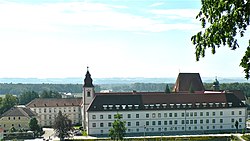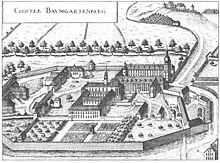Baumgartenberg Abbey
| Baumgartenberg Abbey | |
|---|---|
 Baumgartenberg monastery with monastery and parish church as well as European high school |
|
| location |
|
| Coordinates: | 48 ° 12 '31 " N , 14 ° 44' 34" E |
| Serial number according to Janauschek |
169 |
| founding year | 1141 |
| Year of dissolution / annulment |
1794 or 1784 |
| Mother monastery | Heiligenkreuz Abbey |
| Primary Abbey | Morimond Monastery |
The pin Baumgartenberg is a former monastery of Cistercian (OCist) and today the convent of the Sisters of the Good Shepherd in Baumgartenberg in the district Perg in Upper Austria . The Baumgartenberg Collegiate Church of the Assumption of Mary is today the parish church of the market town. The Baumgartenberg European High School is located in the monastery building.
history
Foundation, endowment
The monastery was founded in 1142 by Otto von Machland († 1148) and his wife Jeuta von Peilstein (south of Melk ). The very first monks came from the Cistercian primary abbey of Morimond , but the establishment between 1154 and 1188 was subordinated to the Cistercian abbey of Heiligenkreuz , and thus remained in the filiation of Morimond.
On the occasion of the founding of the monastery, Otto gave his castle on the Ulrichsberg in Baumgartenberg, including the St. Jakob church, the adjacent Deimingerwald (adjacent to Frühstorf and Kolbing ) and everything he owned there, as well as the Mettensdorf estate including the St. Lamprecht church Labing and the Danube (bordering Matron Elisabeth's fields ), Gassolding near the monastery (bordering the Ammersbach on one side and the Clam Castle area on the other), then mills, pastures, meadows, bodies of water and everything what belonged to the Church of St. Jakob, as well as uncultivated land on the Naarn river (30 Mansus), eight farms with the mill and the forest in Teufenbach, two dairy farms in Eizendorf , two Mansus in Pitzing , eight Mansus in Markersdorf near Retz and Wullerdorf near Mailberg or Wolkersdorf northeast of Klosterneuburg , vineyards in Krems , Ober-Radendorf and Gneixendorf, a field in Harras (Groß- or Kleinharras), from the north forest near Kön igswiesen several Mansus, Nöchling on the Ysper ten Mansus forest. Later on, numerous other properties came to the monastery from other donors or through exchanges and donations.
Cistercian monastery

In 1243 the abbey church, which was built in the late Romanesque style, was consecrated. Around 1426 and 1432 the church and monastery were sacked by the Hussites , but as early as 1434, the church and monastery were rebuilt in the late Gothic style under Abbot Stephan II. In 1627 the parishes of Pergkirchen , Münzbach (until 1681) and Altenburg were incorporated into Baumgartenberg Monastery. Abbot Bernhard Breil (1649–1683) initiated the baroque transformation of the monastery and the church (master builder Antonio Carlone ). Abbot Candidus Pfiffer (1684–1718) continued the Baroque style, but stopped the work around 1700 due to financial difficulties. The collection of document samples from the monastery known as the Baumgartenberger Formelbuch is famous.
In 1784 the monastery was closed by Emperor Joseph II and used as a penal institution until 1811. In 1784 the monastery church became the parish church of Baumgartenberg. In 1825 a fire destroyed most of the convent wing.
Use by other orders
From 1852 to 1865 Jesuits lived in the former Cistercian monastery. In 1865 members of the Order of the Sisters of the Good Shepherd from Suben came there. They dedicated themselves to taking care of difficult to educate girls.
With the Sisters of the Good Shepherd, Franciscans also came to Baumgartenberg as their confessors. In 1889 the Franciscans of the Tyrolean province received an outbuilding of the monastery as a living area and the Baumgartenberg parish for pastoral care. They also worked as religion teachers at the school of the sisters. In summer 2008 this Franciscan settlement was closed.
Upper Austrian coat of arms
The Upper Austrian coat of arms probably goes back to the family of the Lords of Machland, which died out in the 12th century. Two miniatures made around 1335 in the land register of the Baumgartenberg monastery show Machland coats of arms that are very similar to the Upper Austrian coat of arms. The main difference between the coat of arms in the land register and the later state coat of arms is the color. While the miniatures show a silver eagle on a red background, we find a golden eagle on a black background in the national coat of arms.
It is not certain who is the creator of the Upper Austrian coat of arms. The Machland , however, had been part of the Babenberger's rulership since ancient times , and the Habsburgs saw themselves as their successors . It is possible that the Austrian Duke Rudolf IV († 1365) made this coat of arms the coat of arms of the state above the Enns in order to reinforce his claims to the possessions of the extinct Lords of Machland and, implicitly, all of Upper Austria. In addition, the red and white stripes arouse close associations with the Austrian binding shield .
use
Today the sisters run a boarding school for girls and various educational institutions, since 1995 the Good Shepherd European High School run by the school association of the same name has also been housed in the monastery complex.
Buildings and plant
The former collegiate church with transept and choir, which has a turret with an onion helmet and for which the foundation stone was laid in 1142, has a low three-aisled, cross-rib vaulted vestibule ("Paradise", around 1310) with a Romanesque portal. The church was made Baroque around 1697 and goes back to the Carlone workshop (attributed to Carlo Antonio Carlone ). The hall choir, which was later also baroque , was built in 1436–46. The choir frescoes depict the secrets of the rosary . The choir stalls and the pulpit are remarkable. A ambulatory is placed around the chancel, the exterior of which consists of nine sides of a sixteenth corner.
literature
- Festschrift. 850 years of Baumgartenberg. Published by the Baumgartenberg community, Baumgartenberg 1991.
- Franz Xaver Pritz : History of the abandoned Cistercian monastery Baumgartenberg in the country above the Enns. In: Commission for the maintenance of patriotic history of the imperial academy of science (ed.): Archive for customer of Austrian historical sources . Volume 12, Vienna 1854, digitized version on digi.landesbibliothek.at.
- Ludwig Keplinger: Former Baumgartenberg men's monastery in Upper Austria. In: Cistercians in Austria. Salzburg 2004, pp. 163–166, ISBN 3-900173-72-9 .
- Liza Bernadette Fügenschuh: The Baroque transformation of the former Baumgartenberg collegiate church. Diploma thesis, Faculty of History and Cultural Studies at the University of Vienna, 2013 (with PDF on univie.ac.at ).
- Aelred Pexa : Heiligenkreuz and Baumgartenberg. In: Sancta Crux 71, 2010, pp. 157-159.
- Karl Oettinger, Renate Wagner-Rieger, Franz Fuhrmann, Alfred Schmeller: Reclams Art Guide Austria 1. Philipp Reclam jun., 4th edition 1974, pp. 34–35, ISBN 3-15-008605-1 .
- Rudolf Flotzinger : Baumgartenberg. In: Oesterreichisches Musiklexikon . Online edition, Vienna 2002 ff., ISBN 3-7001-3077-5 ; Print edition: Volume 1, Verlag der Österreichischen Akademie der Wissenschaften, Vienna 2002, ISBN 3-7001-3043-0 .
- Monika Soffner-Loibl: Baumgartenberg. Parish Church of the Assumption of Mary, former Cistercian Abbey Church. Peda Art Guide No. 733/2009, Peda Art Publishing House, Passau 2009, ISBN 978-3-89643-733-4 .
- Literature on the Baumgartenberger formula book
- Hermann Baerwald (ed.): The Baumgartenberger formula book. A source on the history of the 13th century, primarily the time of Rudolf von Habsburg (= Fontes rerum Austriacarum. Volume 25). Vienna 1866.
- Paul Scheffer-Boichorst : Smaller researches on the history of the Middle Ages IV: The first relations between Habsburg and Hungary; on the criticism of the Baumgartenberger formula book. In: Communications from the Institute for Austrian Historical Research . Volume 10, 1889, pp. 75ff.
See also
- Baumgartenberg Collegiate Church
- List of monasteries in Austria
- List of listed objects in Baumgartenberg
Web links
- Monastery of the Sisters of the Good Shepherd Baumgartenberg on kloster-baumgartenberg.at.
- Bibliography on Baumgartenberg in the forum OoeGeschichte.at.
- Pictures of the collegiate church on burgseite.com.
- Kathrin Kininger: Collection: Baumgartenberg, Cistercians (1149–1708) in the European document archive Monasterium.net .
Individual evidence
- ↑ Kathrin Kininger: Collection: Baumgartenberg, Zisterzienser (1149–1708) (the foundation took place in 1142 and was only later backdated to May 6, 1141) in the European document archive Monasterium.net .
- ↑ Pritz 1854, p. 8 (Viewer p. 12).
- ↑ Pritz 1854, pp. 9-10 (Viewer pp. 13f).
- ↑ Pritz 1854, p. 37 (Viewer p. 41).
- ↑ Pritz 1854, p. 45 (Viewer p. 49).
- ^ Albert Kern: Farewell to the Franciscans from Baumgartenberg. The order closes its branch in Baumgartenberg after 119 years. News of the closure of the Franciscan branch on franziskaner.at, 2008, accessed on October 5, 2019.
- ↑ a b Klaus Rumpler: Landmarks of the Baumgartenberg monastery in the forum OoeGeschichte.at.
- ^ Upper Austrian Provincial Archives , Pa V / 64, parchment manuscript around 1335, 46 sheets.
- ^ Alfred Hoffmann: The coat of arms and the great letter of freedom of Rudolf IV. In: Communications of the Upper Austrian regional archive. Volume 7, Linz 1961, pp. 299–301 (entire article, pp. 296–303, online (PDF) in the forum OoeGeschichte.at).
- ↑ GM Böhm-Lürgen: The state coat of arms. In: Mühlviertler Heimatblätter . Volume 1, Linz 1961, issue 4, p. 5 ( online (PDF) in the forum OoeGeschichte.at).

